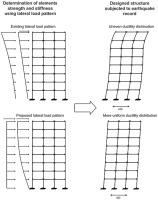当前位置:
X-MOL 学术
›
Soil Dyn. Earthq. Eng.
›
论文详情
Our official English website, www.x-mol.net, welcomes your
feedback! (Note: you will need to create a separate account there.)
Consideration of strength-stiffness dependency in the determination of lateral load pattern
Soil Dynamics and Earthquake Engineering ( IF 4.2 ) Pub Date : 2020-10-01 , DOI: 10.1016/j.soildyn.2020.106287 Parham Ghaderi , Horr Khosravi , Ali Rahmani Firoozjaee
Soil Dynamics and Earthquake Engineering ( IF 4.2 ) Pub Date : 2020-10-01 , DOI: 10.1016/j.soildyn.2020.106287 Parham Ghaderi , Horr Khosravi , Ali Rahmani Firoozjaee

|
Abstract The lateral load pattern used in design can significantly influence the distribution of strength and stiffness and consequently the distribution of damage along the height of the structure. The distribution patterns provided in seismic design codes are primarily derived from the fundamental elastic mode of vibration without considering the inelastic behavior of structures. This code-based load pattern causes concentrated damage in some stories, while leading to inefficient use of materials in other stories. Therefore, recent studies have employed optimization algorithms to develop lateral load patterns that achieve a uniform distribution of damage over all stories. These algorithms usually determine the distribution of strength along the height to achieve a particular ductility, while the stiffness is assumed to be constant. This assumption is contrary to the strength-stiffness dependency in steel or RC elements, hence causing some errors in the proposed load patterns. This paper presents an innovative algorithm to consider strength-stiffness dependency in the development of a lateral load pattern used for the design of moment frames. The proposed algorithm is implemented in MATLAB with supplementary OpenSees codes called in for nonlinear dynamic analysis. To reduce the computational cost of the nonlinear dynamic analysis during the optimization process, original n-bay frames are represented by simplified single-bay frames. The algorithm is implemented 800 times for 5 multi-story building models, 4 target ductility level, and 40 earthquake ground motions, with each implementation requiring a large number of trial and error iterations. The analysis results are processed to achieve two new lateral load patterns, which are evaluated using three original frames subjected to different ground motions. The results demonstrate that the moment frames designed by the proposed load patterns exhibit a more uniform distribution of ductility along the building height compared to the structures designed by the previously proposed lateral load patterns.
中文翻译:

在确定横向荷载模式时考虑强度-刚度依赖性
摘要 设计中使用的横向荷载模式可以显着影响强度和刚度的分布,从而影响沿结构高度的损伤分布。抗震设计规范中提供的分布模式主要来自振动的基本弹性模式,而不考虑结构的非弹性行为。这种基于代码的加载模式会在某些楼层造成集中损坏,同时导致其他楼层的材料使用效率低下。因此,最近的研究采用了优化算法来开发横向载荷模式,从而在所有楼层上实现均匀的损坏分布。这些算法通常确定沿高度的强度分布以实现特定的延展性,而刚度假定为常数。该假设与钢或 RC 元件的强度-刚度依赖性相反,因此会导致建议的载荷模式出现一些错误。本文提出了一种创新算法,用于在开发用于力矩框架设计的横向载荷模式时考虑强度-刚度依赖性。所提出的算法是在 MATLAB 中使用补充 OpenSees 代码实现的,用于非线性动态分析。为减少优化过程中非线性动力分析的计算成本,原始n-bay 框架用简化的single-bay 框架表示。该算法对 5 个多层建筑模型、4 个目标延性水平和 40 次地震地面运动实施了 800 次,每次实施都需要大量的试错迭代。对分析结果进行处理以获得两种新的横向载荷模式,这些模式是使用受到不同地面运动影响的三个原始框架进行评估的。结果表明,与先前提出的横向荷载模式设计的结构相比,由所提出的荷载模式设计的力矩框架沿建筑物高度表现出更均匀的延性分布。
更新日期:2020-10-01
中文翻译:

在确定横向荷载模式时考虑强度-刚度依赖性
摘要 设计中使用的横向荷载模式可以显着影响强度和刚度的分布,从而影响沿结构高度的损伤分布。抗震设计规范中提供的分布模式主要来自振动的基本弹性模式,而不考虑结构的非弹性行为。这种基于代码的加载模式会在某些楼层造成集中损坏,同时导致其他楼层的材料使用效率低下。因此,最近的研究采用了优化算法来开发横向载荷模式,从而在所有楼层上实现均匀的损坏分布。这些算法通常确定沿高度的强度分布以实现特定的延展性,而刚度假定为常数。该假设与钢或 RC 元件的强度-刚度依赖性相反,因此会导致建议的载荷模式出现一些错误。本文提出了一种创新算法,用于在开发用于力矩框架设计的横向载荷模式时考虑强度-刚度依赖性。所提出的算法是在 MATLAB 中使用补充 OpenSees 代码实现的,用于非线性动态分析。为减少优化过程中非线性动力分析的计算成本,原始n-bay 框架用简化的single-bay 框架表示。该算法对 5 个多层建筑模型、4 个目标延性水平和 40 次地震地面运动实施了 800 次,每次实施都需要大量的试错迭代。对分析结果进行处理以获得两种新的横向载荷模式,这些模式是使用受到不同地面运动影响的三个原始框架进行评估的。结果表明,与先前提出的横向荷载模式设计的结构相比,由所提出的荷载模式设计的力矩框架沿建筑物高度表现出更均匀的延性分布。











































 京公网安备 11010802027423号
京公网安备 11010802027423号